The Arizona Preservation Foundation has released its 2006 list of Arizona’s most endangered historic places. Compiled by preservation professionals and historians, the list identifies critically endangered properties of major historical significance to the state. “All of the properties we have named are important historic sites in Arizona, but unfortunately are in grave danger of collapse, demolition, or destruction,” said Vince Murray, vice president of APF’s board and chair of its Most Endangered Historic Places review committee. “It is critical that residents and government officials act now to save these elements of their cultural heritage before it’s too late.”
Individuals interested in ensuring a listing’s preservation are encouraged to send us an e-mail. We appreciate any and all feedback.
APF is Arizona’s only nonprofit statewide historic preservation organization. Founded in 1979, APF is dedicated to preserving Arizona's historical, archaeological, architectural, and cultural resources. APF offers a variety of services and programs, including: Governor’s Heritage Preservation Awards; conferences and workshops on topics such as heritage tourism, adobe conservation, maintenance of historic properties, and government ordinances' impact on local preservation; speaker’s bureau for groups and classes; and Arizona’s Most Endangered Places List.
Sunday, January 22, 2006
Sunday, January 15, 2006
Adamsville Ruins
Adamsville is a large Classic Hohokam habitation site, dating from AD 1100 to AD 1450, consisting of a platform, mound, at least one compound, a ball court, and 41 associated mounds of which some still have standing architecture. Listed on the National Register of Historic Places, it is located near the 19th century town for which it is named. It’s the second largest Hohokam housing area along the Canal Casa Grande, second only to the combined communities of Grewe and Casa Grande. The current size of the site is 155 acres of which 126 acres are proposed for addition to Casa Grande National Monument. The site is threatened by encroachment from commercial development and the State of Arizona is not able to provide adequate protection.
August 2007 Update: The Arizona State Historic Preservation Office continues to seek adequate funding for the site's protection.
August 2007 Update: The Arizona State Historic Preservation Office continues to seek adequate funding for the site's protection.
Basque Pelota Ball Court & Associated Structures
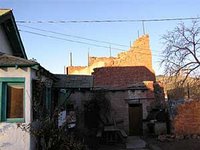 Basque Pelota is a handball-like game played on the borders of Spain and France. When Basques immigrated to America in the 1800s, they brought their sport with them. Approximately two dozen Pelota ball courts exist in the United States. Of that, a dozen or so remain west of the Mississippi and only one remains in Arizona. Currently, there are issues over how the site can be and should be developed. Though the owners would like to preserve the property, their efforts at reuse on the site have been fraught with problems outside of their control. (Photo source: Patty Rubick Luttrell.)
Basque Pelota is a handball-like game played on the borders of Spain and France. When Basques immigrated to America in the 1800s, they brought their sport with them. Approximately two dozen Pelota ball courts exist in the United States. Of that, a dozen or so remain west of the Mississippi and only one remains in Arizona. Currently, there are issues over how the site can be and should be developed. Though the owners would like to preserve the property, their efforts at reuse on the site have been fraught with problems outside of their control. (Photo source: Patty Rubick Luttrell.)August 2007 Update: The City of Flagstaff and property owner are working together to find solutions to protect and preserve this site.
Desert Laboratory on Tumamoc Hill
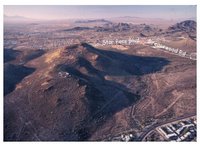 In 1903 the Carnegie Foundation founded the Desert Laboratory on Tumamoc Hill. The 1,730-acre laboratory, the first facility of its kind devoted solely to arid lands research, has remained a permanent natural ecological preserve dedicated to studies of plants, animals, and environment of North American deserts. While there appears to be a long-term commitment on the part of the University of Arizona, City of Tucson, and State of Arizona to maintain the site as a green area and ecological research preserve, the most significant present issue is the continuing difficulty of getting the western 1/3 of the property transferred from the State Education Trust to the University. (Photo source: Linda Mayro.)
In 1903 the Carnegie Foundation founded the Desert Laboratory on Tumamoc Hill. The 1,730-acre laboratory, the first facility of its kind devoted solely to arid lands research, has remained a permanent natural ecological preserve dedicated to studies of plants, animals, and environment of North American deserts. While there appears to be a long-term commitment on the part of the University of Arizona, City of Tucson, and State of Arizona to maintain the site as a green area and ecological research preserve, the most significant present issue is the continuing difficulty of getting the western 1/3 of the property transferred from the State Education Trust to the University. (Photo source: Linda Mayro.)August 2007 Update: Discussions continue between local goverment authorities, the University of Arizona, and State Education Trust to find solutions to protect this site.
First Baptist Church
 Completed in 1930 to serve parishioners in central Phoenix before suburban expansion after World War II, this four-story church includes a roof-top garden, concrete and wood floors, diamond-patterned clerestory windows, Italian gothic motifs, three-pointed arch doorways, decorative cornices, stone columns, and a bell tower. While saved from demolition in 1992 from previous fire damage and despite the best intentions of its current owner, the building continues to lay dormant. (Photo source: Jim McPherson.)
Completed in 1930 to serve parishioners in central Phoenix before suburban expansion after World War II, this four-story church includes a roof-top garden, concrete and wood floors, diamond-patterned clerestory windows, Italian gothic motifs, three-pointed arch doorways, decorative cornices, stone columns, and a bell tower. While saved from demolition in 1992 from previous fire damage and despite the best intentions of its current owner, the building continues to lay dormant. (Photo source: Jim McPherson.)August 2007 Update: Discussions continue between the property owner and other interested parties, including the City of Phoenix and Arizona State University, to find solutions to protect this site. A proposed new multi-story retail/residential development on the northwest corner of the block could impact the project.
Fisher Memorial Home
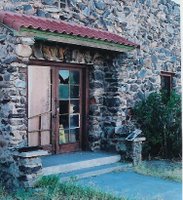 Built in 1927 and listed on the National Register of Historic Places in 1985. When listed, it was considered an outstanding example of a Period Revival residential and commercial building executed in local material of uncoursed fieldstone construction. The house is currently in a significant state of disrepair. Some windows and doors are missing or damaged and the roof is leaking, which can cause structural damage. (Photo source: Marge Jantz.)
Built in 1927 and listed on the National Register of Historic Places in 1985. When listed, it was considered an outstanding example of a Period Revival residential and commercial building executed in local material of uncoursed fieldstone construction. The house is currently in a significant state of disrepair. Some windows and doors are missing or damaged and the roof is leaking, which can cause structural damage. (Photo source: Marge Jantz.)August 2007 Update: Local interest has picked up in finding solutions to the protection of this site.
Geronimo Station
 Located between Safford and Globe on the westbound side of Interstate 70 is the small store, gas station, and four-casita motel (complete with carports between the units). Constructed of adobe in the 1930s and 40s to accommodate travelers heading west, it’s one of the few original buildings still standing in the state-registered historic town-site of Geronimo. The property is in poor condition and is deteriorating from neglect. (Photo source: Kurt Wenner.)
Located between Safford and Globe on the westbound side of Interstate 70 is the small store, gas station, and four-casita motel (complete with carports between the units). Constructed of adobe in the 1930s and 40s to accommodate travelers heading west, it’s one of the few original buildings still standing in the state-registered historic town-site of Geronimo. The property is in poor condition and is deteriorating from neglect. (Photo source: Kurt Wenner.)August 2007 Update: Unfortunately, at least one guest unit roof has caved in, walls continue to deteriorate, and more junk cars are left on the premises.
Meehan/Gaar House
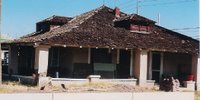 Built in 1903 and listed on the National Register of Historic Places, the house is an unusual example of the Colonial Revival influence executed in adobe. The house is significant for its association with two of Casa Grande's well-known citizens: (1) Tom J. Meehan who built the house and owned Gilt Edge Saloon and served on the Casa Grande Board of Trade and (2) Fanne Gaar who served on the City Council and was the first woman to be elected mayor of an Arizona city. The house is currently in a state of disrepair with deteriorating veranda, roofing, and adobe walls. (Photo source: Marge Jantz.)
Built in 1903 and listed on the National Register of Historic Places, the house is an unusual example of the Colonial Revival influence executed in adobe. The house is significant for its association with two of Casa Grande's well-known citizens: (1) Tom J. Meehan who built the house and owned Gilt Edge Saloon and served on the Casa Grande Board of Trade and (2) Fanne Gaar who served on the City Council and was the first woman to be elected mayor of an Arizona city. The house is currently in a state of disrepair with deteriorating veranda, roofing, and adobe walls. (Photo source: Marge Jantz.)August 2007 Update: Local interest has picked up in finding solutions to the protection of this site.
Mesa Grande Ruins
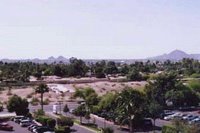 A sister mound to Pueblo Grande on the north side of the river, Mesa Grande is one of only two remaining Hohokam mounds in metro Phoenix. Just a little larger than a football field in both length and width and 27 feet tall at its highest point, the mound remains intact with very few excavations that have impacted its integrity. By putting the site into public ownership in the mid-1980s, Mesa was able to "preserve" the site, but the City has not funded any public facilities or property upgrades, with the exception of a new fence. Minor vandalism has occurred. (Photo source: Tom Jonas.)
A sister mound to Pueblo Grande on the north side of the river, Mesa Grande is one of only two remaining Hohokam mounds in metro Phoenix. Just a little larger than a football field in both length and width and 27 feet tall at its highest point, the mound remains intact with very few excavations that have impacted its integrity. By putting the site into public ownership in the mid-1980s, Mesa was able to "preserve" the site, but the City has not funded any public facilities or property upgrades, with the exception of a new fence. Minor vandalism has occurred. (Photo source: Tom Jonas.)October 2007 Update: "Grant comes through for Mesa Grande Ruins," Arizona Republic, October 9, 2007.
Mountain View Black Officers Club
 High on a hill overlooking Fort Huachuca Army base in Sierra Vista sits a dilapidated building that once echoed with the sublime song stylings of Lena Horne during World War II. She came to entertain the black troops at the Mountain View Black Officers Club, built in 1942 by the then-segregated Army for its growing number of black soldiers. A plan to preserve that building and turn it into a black military research center is on the drawing board, but an estimated $3 million is needed to save and convert the club. Pictured is retired Army 1st Sgt. Tom Stoney Sr., combat veteran of Korea and member of the Southwest Association of Buffalo Soldiers. (Photo source: Barbara Alper, Parade Magazine.)
High on a hill overlooking Fort Huachuca Army base in Sierra Vista sits a dilapidated building that once echoed with the sublime song stylings of Lena Horne during World War II. She came to entertain the black troops at the Mountain View Black Officers Club, built in 1942 by the then-segregated Army for its growing number of black soldiers. A plan to preserve that building and turn it into a black military research center is on the drawing board, but an estimated $3 million is needed to save and convert the club. Pictured is retired Army 1st Sgt. Tom Stoney Sr., combat veteran of Korea and member of the Southwest Association of Buffalo Soldiers. (Photo source: Barbara Alper, Parade Magazine.)November 2007 Update:
- "Preserving Black History in the Military, at the 'Colored Officers Club,'" New York Times, November 2, 2007.
- Good progress has been made in securing the property and raising funds for the site's restoration. For more information, contact Larry Soule, SWABS president, by e-mail.
Peter T. Robertson Residence
 A 1905 brick cottage with Neo-Classical influence listed on the National Register of Historic Places. Peter T. Robinson was a prominent local attorney, active in community affairs. The house is vacant and is regularly broken into. The roof is open to the sky, the floor is caving in, and a small fire destroyed the east portico and some of the roof over the kitchen. (Photo source: Vince Murray.)
A 1905 brick cottage with Neo-Classical influence listed on the National Register of Historic Places. Peter T. Robinson was a prominent local attorney, active in community affairs. The house is vacant and is regularly broken into. The roof is open to the sky, the floor is caving in, and a small fire destroyed the east portico and some of the roof over the kitchen. (Photo source: Vince Murray.)August 2007 Update: Site visit underway to determine status.
Southern Pacific Railroad Depot
 Built in 1939 and listed on the National Register of Historic Places, the depot is a rare example of Pueblo/Deco architecture. It's one of only a few surviving railroad depots using Pueblo style architecture with Art Deco features. The building has been listed previously on APF’s Most Endangered Properties List. The building is still owned by Union Pacific Railroad and sits in their right-of-way. The City has been attempting to purchase the property or get the railroad's permission on applying for grants to stabilize the structure for several years. (Photo source: Marge Jantz.)
Built in 1939 and listed on the National Register of Historic Places, the depot is a rare example of Pueblo/Deco architecture. It's one of only a few surviving railroad depots using Pueblo style architecture with Art Deco features. The building has been listed previously on APF’s Most Endangered Properties List. The building is still owned by Union Pacific Railroad and sits in their right-of-way. The City has been attempting to purchase the property or get the railroad's permission on applying for grants to stabilize the structure for several years. (Photo source: Marge Jantz.)October 2007 Update: "Casa Grande still wants to save historic depot," Casa Grande Valley Newspaper, October 24, 2007.
August 2007 Update: Local interest has picked up in finding solutions to the protection of this site.
Sun Mercantile Building
 Designed by E.W. Bacon and constructed by Wells & Son, the 1929 Sun Mercantile Building is the first and only known warehouse built and owned by a Chinese-born businessman in Phoenix (Tang Shing). It is the last remaining building of the city’s second Chinatown. Developers of a hotel and condo project want to insert an 11-story tower inside the walls of this city-owned structure, listed on both the National Register of Historic Places and Phoenix Historic Property Register. After the City Council's unanimous vote on December 14, 2005 to allow the "facadomy," a dozen groups associated with the Save SunMerc Coalition filed an appeal in Maricopa County Superior Court. (Photo source: Steve Dreiseszun and Steve Weiss.)
Designed by E.W. Bacon and constructed by Wells & Son, the 1929 Sun Mercantile Building is the first and only known warehouse built and owned by a Chinese-born businessman in Phoenix (Tang Shing). It is the last remaining building of the city’s second Chinatown. Developers of a hotel and condo project want to insert an 11-story tower inside the walls of this city-owned structure, listed on both the National Register of Historic Places and Phoenix Historic Property Register. After the City Council's unanimous vote on December 14, 2005 to allow the "facadomy," a dozen groups associated with the Save SunMerc Coalition filed an appeal in Maricopa County Superior Court. (Photo source: Steve Dreiseszun and Steve Weiss.)September 2007 Update: Maricopa County Superior Court Judge Peter Swann issues his latest ruling on September 17, 2007. Related article in the September 19, 2007 Arizona Republic and related article in the September 26, 2007 Arizona Republic.
Subscribe to:
Comments (Atom)